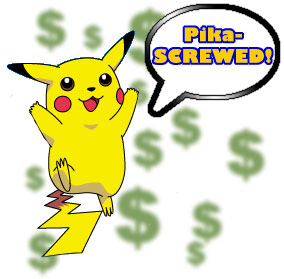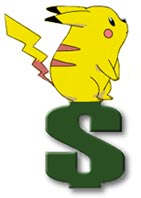
|
Pokemon trading market collapses; kids get a lesson in high-fliers
|
 BY JULIAN E. BARNES New York Times BY JULIAN E. BARNES New York Times
Originally printed January 20, 2001
Mike Loprete stood at the counter of a comic-book store, slowly shook his 11-year-old head and remembered when he was rich. Back in 1999, when the Pokémon fad was the talk of every playground, Mike's collection of cards, neatly stored at his home in Roseland, N.J., was worth hundreds of dollars. But like investors in dot-com flameouts and other once-highflying technology stocks who thought the Nasdaq could rise forever, Mike sat on his assets and watched them dwindle away. "I should have sold,'' Mike said. "I could have had three times as much as I paid for them.'' Fads and fancies have sent the value of all kinds of assets soaring since the earliest days in finance. And from 17th-century Dutch tulips to present-day Internet stocks, such bubbles have inevitably burst. But for millions of young Americans, their first introduction to volatile markets has been Pokémon trading cards. A large number of them have been given a hard lesson about how scarcity can temporarily drive up prices, but that many assets -- be they Pokémon cards or technology companies -- are valuable only if sold at the right time. A year ago, Pokémon cards were the most popular plaything on the planet. Elementary schools were forced to ban the cards as schoolyard speculators ignored their math homework and frenetically bought and sold rare holographic foil cards on the playground. Dealers marked up $3 packets of cards to $12 or more. The rarest cards sold for as much as $375. Now the card market has virtually collapsed and Pokémon ``thousand-aires'' have watched their net worth be wiped out. At New World Manga, a store in Livingston, N.J., specializing in comics and card games, children still gather every Friday for the weekly Pokémon league. But even many of these diehard players said the glory days of collecting had passed. No more cash trades  As others played the card game behind him, Alex Formato, a 12-year-old Pokémon collector from West Orange, N.J., sold three relatively rare cards to Tung Cheng, co-owner of New World Manga. Last year, Alex would have been paid in cash. These days he just gets store credit, a sign of how far the Pokémon market has fallen. Alex has some 10,000 cards, and there are days he wonders why he held on to them. Why didn't he sell last spring when Pokémon cards were still the hottest thing around? As others played the card game behind him, Alex Formato, a 12-year-old Pokémon collector from West Orange, N.J., sold three relatively rare cards to Tung Cheng, co-owner of New World Manga. Last year, Alex would have been paid in cash. These days he just gets store credit, a sign of how far the Pokémon market has fallen. Alex has some 10,000 cards, and there are days he wonders why he held on to them. Why didn't he sell last spring when Pokémon cards were still the hottest thing around?
"I have the original set completed,'' Alex said. "Everyone used to want the whole set. It would have been worth $400; now it's $200 or less.'' On eBay, the highest bids for the first edition base-set Charizard, a rare Pokémon card once valued at $375, have been $100 lately. Booster packs that dealers were paying $4.75 for can now be had for $1, said Brian Wallos, a collectibles dealer. Boxes of Japanese cards that a year ago fetched $300 now sell for $80, he said. Wallos dove into the Pokémon fad in 1999 but these days he is back to buying and selling Beanie Babies. And kid culture has moved on to the next thing. "Now everyone likes Digimon,'' said Molly Berenhaus, 10, after winning a game during last week's Pokémon league at New World Manga. Michael Krois, the chief executive of Affiliate Pros, which runs a Pokémon card trading site, said he had watched the number of cards sold on his site plummet just as the bull market began to lose steam. "I found the amount of cards sold on my site was directly proportional to the stock market's value,'' said Krois. When it dipped, I sold fewer cards. The number of daily visitors to my site, just like Nasdaq, peaked in April.'' Toy companies lose The first casualties of the fall of Pokémon, created by Nintendo (Editors note:There is no longer a prominent Pokémon link on Nintendo.com's front page), were the toy companies. Wizards of the Coast, the Hasbro division that publishes the cards and operates specialty stores that sell them, laid off 100 people last month after citing softening demand for Pokémon. Inside a Wizards of the Coast store in Woodbridge, N.J., Mike Reilly smiled as he recalled the thrill he felt during the height of the Pokémon craze: March 21, 1999. That was the day when the Pokémon road tour came to Woodbridge Center, Mike's hometown mall. Every store in the mall sold out of Pokémon cards, and Mike, 16, sat in a corner with his protective binders, selling from his collection of 2,000 cards. He made $180 that day, but decided to sell only a few cards and keep the best ones. "I held on to most of the cards because I thought the prices would go up more,'' he said. "But now the whole Pokémon fad is starting to die down.'' Other youngsters have been left wondering why anyone was paying more than $300 for a single shiny trading card in the first place. "It's kind of funny that regular cards with foilly stuff on them were ever worth so much,'' said Molly, the 10-year-old who does not care about card prices but is disappointed that it is getting harder and harder to find people with whom to play the actual Pokémon game. But more than a few Pokémon players, like tech-stock bulls who saw Gateway's disappointing holiday computer sales figures as a buying opportunity, think the game will be back. Jimmy O'Brien, a longhaired 14-year-old with a wispy mustache as well as a Pokémon baseball cap and jacket, said part of the problem was that people were selling Pokémon at outrageous, unjustifiable prices. But he does not think the Pokémon cards are down for good. Is comeback in the cards? "Everything old is new again,'' said Jimmy, who has traveled to Los Angeles and Minnesota to compete in Pokémon tournaments. "Lava lamps went out and came back, so this might, too.'' But there are other former Pokémon players who say the game is over. The cards, part of an elaborate marketing campaign, were created for two players to face off with their own carefully constructed decks of Pokémon characters. Players randomly draw several Pokémon from their deck, then flip coins to see how much damage their characters can inflict on their opponents. But the game is based too much on luck and not enough on strategy, argue some disillusioned players. Colin Oettle, 13, of Livingston, bought his first Pokémon cards in 1998 before the fad really took off. When other kids caught on, he watched the list price of his cards surge past the value of his carefully compiled collection of glass collected from beaches and wondered what he should do. "I've thought about selling from time to time and get the extra money,'' Colin said, "but I've never done it.'' Colin's mother, Robin Oettle, 48, a graphic artist, plays with her son in New World Manga's Pokémon league. She is happy the card prices have fallen and does not have any regrets that her son did not cash out. "For me it's a turnoff to have to spend a lot of money on cards,'' she said. "Neither of us would ever sell. Both of us are too nostalgic. I know what it will feel like for him to be 30 and find his Pokémon collection. That is something more valuable than making a few bucks.'' Now that the market has collapsed, Colin said he could not obsess over the missed opportunity, advice investors in, say, Priceline.com or Pets.com may find hard to be so grown-up about. Colin is moving on to playing Magic now, but said his Pokémon days had honed his skills at addition, improved his organization and taught him about the value of collecting, not to mention the fickleness of markets. "It's a little disappointing,'' Colin said. "But life is life.''
  
|









